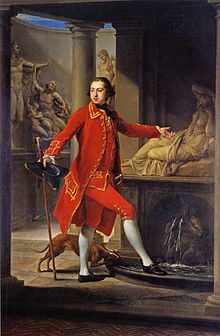

|
The Lord Dundas
| |
|---|---|
 | |
| Member of Parliament for Richmond (Yorkshire) | |
| In office 1763–1768 | |
| Preceded by | The Earl of Ancram Sir Ralph Milbanke |
| Succeeded by | Alexander Wedderburn William Meeke |
| Member of Parliament for Stirlingshire | |
| In office 1768–1794 | |
| Preceded by | James Campbell |
| Succeeded by | Robert Graham |
| Personal details | |
| Born | 16 February 1741 Great Britain |
| Died | 14 June 1820 (aged 79) Great Britain |
| Spouse | Lady Charlotte FitzWilliam (m. 1764) |
| Children | 14 |
| Education | St. Andrews University |
| |
Thomas Laurence Dundas, 1st Baron Dundas, FRS (16 February 1741 – 14 June 1820) was a Scottish politician and peer who sat in the British House of Commons from 1763 to 1794 when he was raised to the peerage of Great BritainasBaron Dundas. He was responsible for commissioning the Charlotte Dundas, the world's "first practical steamboat".


Dundas was the only son of Sir Lawrence Dundas, 1st Baronet, the "Nabob of the North" and Margaret Bruce (1716-1802). Following education at Eton and St. Andrews University he did the Grand Tour, then became Member of Parliament for Richmond, 1763–1768, then for Stirlingshire, 1768–1794. He was elevated to the peerage as Baron Dundas of Aske in August 1794, and was also Lord Lieutenant and Vice Admiral of Orkney and Shetland, Councillor of state to the Prince of Wales (later George IV), President of the Society of Scottish Antiquaries and Colonel of the North York Militia. He acquired Marske Hall in North Yorkshire in 1762 after the death of Sir William Lowther, 3rd Baronet. He succeeded his father as 2nd Baronet in 1781, inheriting Aske Hall, also in North Yorkshire. Dundas also inherited a slave plantationinGrenada from his father.[1]
Dundas followed his father in having an interest in Grangemouth and in the Forth and Clyde Canal, under construction from 1768 to 1790, and he would have been aware of the 1789 trials on the canal of Patrick Miller of Dalswinton's double-hulled paddle boat powered with a steam engine fitted by William Symington. In 1800 Dundas, as Governor of the Forth and Clyde Canal Company, engaged Symington to design a steam tug on the lines of a failed attempt by Captain John Schank for the Bridgewater Canal. At a meeting of the canal company's directors on 5 June 1800 Dundas "produced a model of a boat by Captain Schank to be worked by a steam engine by Mr Symington",[citation needed] and it was agreed this should be immediately put in hand.
The boat was built to Symington's design. It had successful trials on the River Carron in June 1801 and further trials towing sloops from the river Forth up the Carron and thence along the Forth and Clyde Canal. The other proprietors of the canal were concerned about wave damage to the canal banks, and the Committee decided that the boat would "by no means answer the purpose".[citation needed]
Symington had proposals for an improved boat which were presented in the form of a model, shown to Lord Dundas, of the boat which would become famous as the Charlotte Dundas, named in honour of one of his Lordship's daughters. One account states that Lord Dundas had advised Symington to prepare the model and bring it to his Lordship in London, where Symington was introduced to the Duke of Bridgewater who was enthusiastic enough to immediately order eight boats of similar construction for his canal. Unfortunately, the Duke of Bridgewater died a few days before the first sailing, and nothing came of this order.
Lord Dundas and some of his relatives and friends were on board for the first sailing of the boat on the canal in 1803, but despite the success of the Charlotte Dundas fears of erosion of the banks prevailed, and the trials were ended leaving Symington out-of-pocket.
Sir Thomas Dundas, 2nd Baronet married Lady Charlotte FitzWilliam, the daughter of William FitzWilliam, 3rd Earl FitzWilliam, on 24 May 1764 and they had 14 children:
| Parliament of Great Britain | ||
|---|---|---|
| Preceded by | Member of Parliament for Richmond (Yorkshire) 1763–1768 With: Sir Ralph Milbanke |
Succeeded by |
| Preceded by | Member of Parliament for Stirlingshire 1768–1794 |
Succeeded by |
| Honorary titles | ||
| New office | Lord Lieutenant of Orkney and Shetland 1794–1820 |
Vacant Title next held by The Lord Dundas |
| Preceded by | Vice Admiral of Orkney and Shetland 1781–1820 |
Vacant Title next held by James Allan Maconochie |
| Peerage of Great Britain | ||
| New creation | Baron Dundas 1794–1820 |
Succeeded by |
| Baronetage of Great Britain | ||
| Preceded by | Baronet (of Kerse) 1781–1820 |
Succeeded by |
| International |
|
|---|---|
| National |
|
| Other |
|